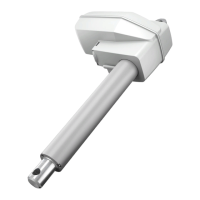Page 66 of 295
Potentiometer
The potentiometer function is mechanically attached to the spindle and registers the number of spindle revolutions. The signal from the potentiometer is
measured in Ohm, where the lowest value is measured when the actuator has been run into inward switch stop. The potentiometer is a 10 - turn and
therefore it is dependent on the stroke length/spindle pitch. see figure 6.5
Mechanical spline
The splines function so that the actuator can only push, not pull. During pull in the actuator, the inner tube is lifted off the thread bush, and the actuator
can therefore never pull a load, only push. See Figure 8.
Functional test of mechanical splines
When the piston rod is at the innermost position, it must be possible to pull it out manually to its full travel length and to press it in again. When used in
a vertical position the force needed to activate the mechanical spline is maximum 60 N + the weight of the application. To reengage the spline function, a
force of maximum 60 N is needed. If this is not possible, contact your nearest LINAK dealer.
Electrical splines
In the rear fixture on the actuator, a microswitch is fitted, which turns off the motor, if the actuator is exposed to pull forces.
Functional test of electrical splines
It is important that the actuator is correctly fixed with regard to the section on page 11. For mounting, see Figure 7.
When the actuator is correctly fixed/mounted, the inward movement of the piston must stop, when the actuator is pulled or the movement is blocked, so
that the back fixture is not put under undue stress/tension.
Quick Release
LA34 (34xxxF/H) is equipped with a function which permits operation of the actuator should the power source fail. Condition for functioning: the actuator
must be loaded in push direction (LA34xxxF) or pull direction (LA34xxxsH).
Warning
• If the actuator does not work as described above, the risk of injury due to squeezing can arise. Therefore, the actuator must be sent immediately for
service at the nearest, authorised LINAK workshop.
• The actuator must not be used in pull applications when the Quick Release is activated, as the risk of personal injury can arise.
• Do only use the actuator within specified working limits.
Activation of Quick Release
Pull the release handle in the direction of the piston rod eye (outwards), the harder you pull the button the quicker the actuator runs down.
When releasing the button the emergency lowering stops immediately. The emergency lowering is activated as long as the load on the actuator is above
100 - 150 kg. The actuator is ready for normal use when the emergency lowering is finished.
Safety device regarding functional failure of the nut (Safety nut)
The LA34 has a built-in safety nut in push as standard and is available with a safety nut in pull as an option. Actuators with safety nut in push can only
function when used in push applications. The safety nut comes into operation should the main nut fail.
Afterwards it is only possible to drive the actuator into the innermost position. Safety nut in pull is for pull applications and works the opposite way as
described above. Thereafter, the actuator will not function any more and must be sent for service.
Built-in end-stop circuit
In the actuators mentioned the end-stop switch is part of the actuator construction. Each time the actuator reaches end-stop position, the switch is activated
and the current is cut off.

